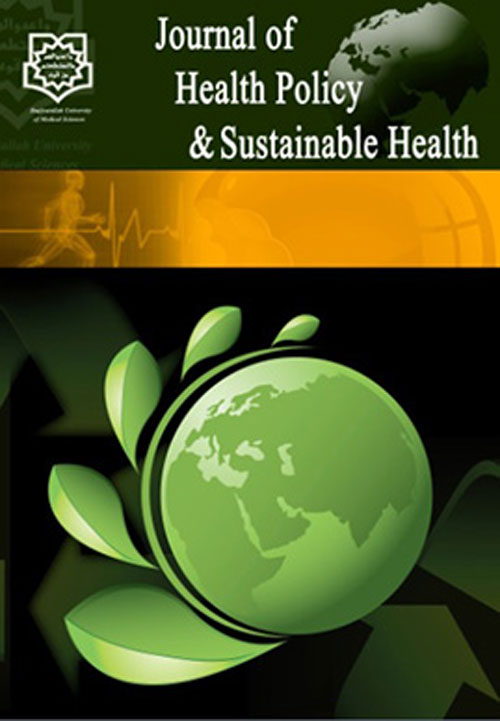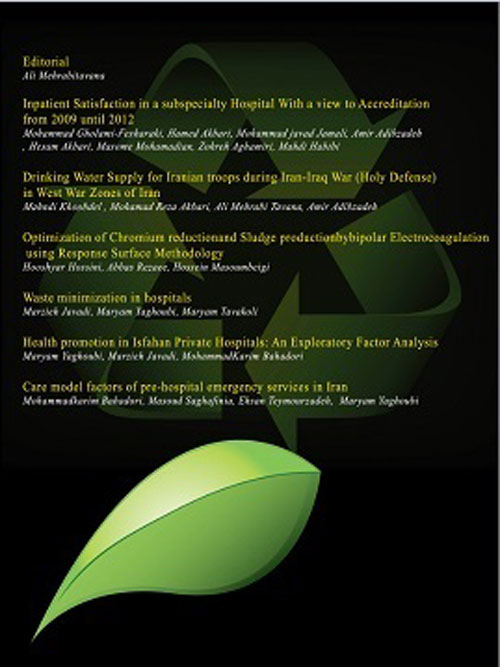فهرست مطالب

Journal of Health Policy and Sustainable Health
Volume:1 Issue: 4, Autumn 2014
- تاریخ انتشار: 1394/02/28
- تعداد عناوین: 7
-
Pages 115-120IntroductionAccording to the principle 29 the Constitution of Islamic Republic of Iran, receiving social security and health care is a public right, Access to a variety of safe and healthy food is a basic human right. Food services and proper nutritional care in hospitals have beneficial effects on the patients’ improvement and the quality of their lives. Customer satisfaction should be a main goal of any organization because the customer satisfaction increases health promotion. The gap analysis model is one of models used for the assessment of the quality of provided services by service organizations. This model can be applied in all service organizations in order to assess the quality of provided services. This study aims to investigate the quality of food services through various methods of preparing, cooking and distributing food in hospitals affiliated to Tehran University of Medical Sciences.MethodsThis descriptive, analytical, cross-sectional study was conducted in 2012. As there are three methods of delegating food service in 5 hospitals affiliated to Tehran Universities of Medical Sciences, the valid questionnaire (Servqual) is used to gather data and measure the quality of food services. The reliability was assessed through needed tests using the test-retest method and Cronbach''s alpha (0.84). The collected data were analyzed using SPSS version 17 software.ResultsFrom the patients’ viewpoint, the biggest gap regarding the quality of food services has been associated with the outsourcing method while the smallest gap regarding the quality has been related to insourcing method. From the employees’ viewpoint, the biggest quality gap has been associated with the outsourcing method while the smallest quality gap has been related to the insourcing method.ConclusionAccording to the patients’ and employees’ viewpoint, the highest quality of food department services, based on the five dimensions of the Servqual model, is attributed to the insourcing method while the lowest quality of food department services based on the five dimensions of the Servqual model is associated with the outsourcing method. The satisfaction level of patients and employees with food department services in hospitals in which raw material is prepared through insourcing method by the hospital and cooking and distribution of food are of the responsibility of the contractor is better than that of the outsourcing method.Keywords: Preparation, Cooking, Distribution, Hospital, Servqual Model
-
Pages 121-124IntroductionSubstances abuse is an important public health concern with social, economic and health consequences. This study aim was to investigate the self-reported beliefs about substance abuse among undergraduate students of the University of Tehran.MethodsThis is an analytical and cross-sectional study which performed in 300 students who entered into the University of Tehran on October 2011. A self-made questionnaire which containing 14 demographic questions (age, gender, height, weight, level of education and the faculty, parents’ education, and employment status), 4 questions about the behavior of substance abuse(SA) experience, 2 essay questions about the benefits and harms, as well as complications and risks of SA.Results56% of the 300 students (n=168) were female and 44% (n=132) were male; the mean of participants age was 23.2 ± 5.1 years old. Most of them (109 Ss- 36.33%) mentioned that the most important effect of Substances is causing various physical and mental disorders, as well as disorders in various organs of their body. The second most important effect was social harms. Several students had stressed the importance of education.ConclusionDespite the beliefs in accordance with the harms of substance abuse, the students pointed to the substances’ calming effect and reducing stress. Therefore, further education must be provided for this group in order to reduce the reinforcing beliefs of substance abuse.Keywords: Substance abuse, Students, Perception
-
Pages 125-129IntroductionThis research has been conducted in order to study predictability of Gardner''s multiple intelligence theory in selecting major between medical and non-medical students in 2014.MethodThis research is descriptive-survey. Participants are all of the medical and non medical sciences students of Isfahan University in the academic year 2014. Using sampling method, 150 individuals were selected as sample. Data were obtained using standard questionnaire of Gardner''s multiple intelligence and analyzed by SPSS software.ResultsAccording to obtained results, among 9 subscales of multiple intelligence best predictors in naturalist and interpersonal subscales for medical students and existentialist, intrapersonal and logical-mathematical subscales for non-medical students. Also there is difference between multiple intelligences of students of medical and non-medical group and male and female students.ConclusionResults showed that medical, human sciences and basic sciences students can be differentiated in terms of Gardner''s intelligence.Keywords: Multiple Intelligence, Choosing Major
-
Pages 131-136According to the principle 29 the Constitution of Islamic Republic of Iran, receiving social security and health care is a public right, and its preparation from public revenues and resources resulting from all of the citizen’s participations has been undertaken by the government. This analytic-descriptive research tries to evaluate the current status of the financial system in health care area. Identify the weaknesses, determine the indicators of an efficient financial system, and provide solutions to improve the efficiency of health care. Hence, we have used the comparative study of health systems in some countries. The results of the current research show that in spite of the fact that the budget allocated to the health system does not conform to the international standards, the main problem is not the budget shortage, but is the ways to allocate and manage the budget. First part of studies says how to increase funds, and second part is about the optimal allocation of these resources and how to budget efficiently according to the world’s most successful system approaches. Although some mechanisms such as taxes are highly desirable for providing the resources of health system, it isn’t so possible in Iran, because of the necessity of some extensive evolutions in taxation system, and the difficulties of doing so, or at least the necessity of passing a long time process besides providing infrastructures. This way, the other ways of gathering funds are reachable simpler. It seems necessary to apply new policies regarding the structure and management of financial resources in order to decrease paying directly from pockets.Keywords: Health Care, Financing System, Budgeting, Efficiency
-
Pages 137-140IntroductionAlthough several studies were conducted in the spiritual well-being and religious orientation, the relationship between these two factors were not considered. This research investigated the relationship between religious orientation and spiritual health among staffs of a military university.MethodThe cross-sectional study was conducted during 2011-2012 on the staff (n 503) of a military academy that were selected through stratified sampling. Ellison and Paloutzian''s spiritual well-being scale (SWBS) and Azarbayejani’s religious orientation questionnaire were used to data collection. Data were analyzed by using SPSS ver 16. software and Pearson correlation test.Results61.4% of the participants had a good score of spiritual health and 74.2% had a good religious orientation. The Pearson Correlation test showed a significant correlation between religious orientation and spiritual health (r= 0.29, P=0.05).ConclusionSpiritual health can be improved through strengthening religion orientation. Therefore, it is recommended staff be provided with in-service religious education in order to maintain and promote their health and well being.Keywords: Religion, Medicine, Health
-
Pages 141-144IntroductionThe present study is an attempt to survey the reasons for the physicians’ reluctance to take part in the family physical program in the Tehran province health care system.MethodsConsidering this purpose, the study is an applied work carried out through a correlative method in Tehran’s Province Health System in 2012. The study population was comprised of all the physicians in the Tehran Province health system. The participants were selected through census sampling procedure. A questionnaire was used for data gathering and the data were analyzed using SPSS16.ResultsThe mean point of economic stage, work conditions, health, welfare, structural organizational, and social-cultural problems in the health centers under study were less than midpoint. Additionally, a statistically significant relationship was found between these problems and the tendency of physicians to take part in the family physician program (P<0.05).ConclusionThe results indicated a significant relationship between the problems of physicians and their tendency to take part in the family physician program in Tehran. Given the necessity of creating motivation among physicians to take part in the program effectively and willfully, solving the physicians’ problems appears to be effective in motivating the physicians in this regard.Keywords: Family Physician, Referral System, Problems of Family Physicians, Health Centers


